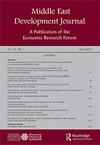Unemployment hysteresis in Middle East and North Africa countries: panel SUR-based unit root test with a Fourier function
IF 0.8
Q4 DEVELOPMENT STUDIES
引用次数: 2
Abstract
ABSTRACT Unemployment hysteresis of Middle East and North African (MENA) countries is investigated under a battery of unit root testing frameworks in the extant literature, including a recently proposed Panel SUR Dickey-Fuller-like unit root test with Fourier and Exponential Smooth Transition Regression (ESTR) nonlinearities. The Fourier function allows for smooth nonlinear breaks, while the ESTR nonlinearity allows for instantaneous breaks. The two nonlinearity types make the recent approach quite appealing. It has, however, been scarcely applied to empirically test the unemployment hysteresis hypothesis. Although we find conflicting stances from ADF, FADF and ADF-SB testing frameworks, evidence of unemployment hysteresis effect in Lebanon is consistent across all three tests. The ADF and FADF tests confirmed the hysteresis hypothesis in Kuwait and Lebanon, while FADF-SB rejected the unemployment hysteresis hypothesis across all the 19 MENA countries. The results from the KSS and FKSS unit root testing frameworks consistently affirmed the hysteresis effect in Oman and Turkey, while there are mixed stances for Kuwait and Lebanon. The results from SURADF and SURKSS only supported the hysteresis hypothesis in Turkey, while the same was confirmed only for Bahrain under the SURFADF and SURFKSS testing frameworks. The unemployment hysteresis hypothesis is confirmed for 12 (about 63.15% of the total number considered) MENA economies.中东和北非国家的失业滞后:基于面板SUR的傅立叶函数单位根检验
本文在现有文献中的一系列单位根检验框架下研究了中东和北非(MENA)国家的失业滞后,包括最近提出的具有傅里叶和指数平滑过渡回归(ESTR)非线性的Panel SUR dickey - fuller样单位根检验。傅里叶函数允许平滑的非线性中断,而ESTR非线性允许瞬时中断。这两种非线性类型使得最近的方法非常吸引人。然而,它很少被用于对失业滞后假说进行实证检验。尽管我们发现ADF、FADF和ADF- sb测试框架的立场相互矛盾,但黎巴嫩失业滞后效应的证据在所有三个测试中都是一致的。ADF和FADF检验证实了科威特和黎巴嫩的滞后假说,而FADF- sb则否定了所有19个中东和北非国家的失业滞后假说。KSS和FKSS单位根测试框架的结果一致地证实了阿曼和土耳其的滞后效应,而科威特和黎巴嫩的情况则不同。SURADF和SURKSS的结果仅支持土耳其的滞后假设,而在SURFADF和SURFKSS测试框架下,同样的结果仅在巴林得到证实。失业滞后假说在12个MENA经济体(约占考虑总数的63.15%)中得到证实。
本文章由计算机程序翻译,如有差异,请以英文原文为准。
求助全文
约1分钟内获得全文
求助全文

 求助内容:
求助内容: 应助结果提醒方式:
应助结果提醒方式:


